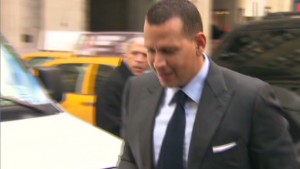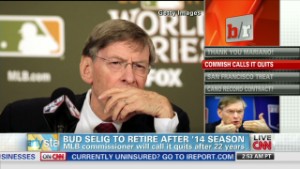Editor's note: Mike Downey is a former columnist for the Los Angeles Times and Chicago Tribune.
(CNN) -- Baseball's not a contact sport.
It is not football, where rock-abbed men brutalize each other to get the ball. It is not hockey, where a guy on ice skates gets "checked" (aka whacked) if he's got the puck.
It isn't even basketball, where 7-foot mastodons give each other a shove on the spine and a thump in the rump, jostling for a few precious feet of space by the hoop.
 Mike Downey
Mike Downey No, baseball is not played that way.
With one exception.
"Collisions at home plate." That is what they are called, in the lingo of the game. "A collision at the plate."
It occurs principally when a man is running at full speed, attempting to score a run for his side. If the ball gets there ahead of him, a catcher, shielded by equipment that includes a mask, shin guards and a Kevlar-like protective vest, like a cop from a SWAT squad, blocks the plate. Wham. Runner smashes into catcher, who must "tag" him with the ball (and not drop it) before that runner can step on home plate.
 A-Rod blows cool, storms out of hearing
A-Rod blows cool, storms out of hearing  Decoding the perfect baseball swing
Decoding the perfect baseball swing  MLB Commissioner to retire after 2014
MLB Commissioner to retire after 2014 Savannah Guthrie, co-host of NBC's "Today" morning show, innocently professed her ignorance of baseball on Thursday, saying: "I never thought that was a play. ... I thought it was an accident."
No, it is quite deliberate. A runner runs as hard as he can into a catcher, becoming a human crash-test dummy.
Very exciting.
Unfortunately, there is a side effect. Somebody stands a chance of getting seriously hurt. Broken bones. Cartilage damage. Brain trauma.
Is this necessary? Is the "collision at home plate" such a key element of a centuries-old sport that the show must go on? Are we a bunch of wusses now, no longer willing or able to play this game in the way that our daddies and granddaddies did?
Or are we finally coming to our senses?
Major League Baseball believes the latter to be true. A proposal is being made, to be formally presented to team owners in January, to forever eliminate the "collision" from the baseball vernacular and rulebook.
No more bowling over the catcher. No more trying to "knock the ball out of his hands." No more trying to "knock him into the middle of next week," to quote some lame 20th century slang.
From now on, if agreed upon by all, a runner must slide into home plate -- or at the very least try to dodge the catcher and the ball -- rather than plow into him like a steer into a matador.
Concussions are becoming much too commonplace. Up-to-date medical knowledge is demonstrating how many ex-athletes suffer everlasting degeneration from the impacts of violent incidents on the field of play.
No matter how much you love the great game of baseball, you couldn't possibly believe that it would be less great a game if we no longer make a catcher "stand his ground" and await a blunt-force crash with a fellow human being.
Or could you?
People who follow baseball get their noses out of joint whenever somebody tries to change a rule. Instant replay would be a big help? No, it wouldn't. A time clock on the batter or pitcher would speed things up? Nuts to that. Warnings to both benches and mandatory ejections if a pitcher throws a ball at a batter on purpose? Namby-pamby nonsense. Don't fix what ain't broke! (Some people say.)
But come on, this is a good thing, right? Keeping a catcher from getting killed? Or a runner from breaking his neck?
This is a good thing, right? Keeping a catcher from getting killed? Or a runner from breaking his neck?Mike Downey
Because that's what "collisions" cause, yes? Serious injury and potentially even death?
How did ex-catcher Bruce Bochy, now the manager of the San Francisco Giants, put it in a New York Times piece this week? "I think it's better to be proactive before we carry a guy off the field paralyzed and think, 'Why didn't we change this rule?' "
Amen to that.
Ballplayers current and past understand the danger. Bochy saw his star catcher, Buster Posey, severely injured in May 2011 when he was smashed into by Scott Cousins of the Florida (now Miami) Marlins, breaking a fibula and being lost for the rest of the year. Brian Sabean, the Giants' general manager, described Cousins' actions that day with the word "malicious."
But rules are rules, until we change them.
Managers galore are former catchers: Bochy, Mike Scioscia (Angels), Joe Girardi (Yankees), Joe Maddon (Rays), Mike Matheny (Cardinals), Ned Yost (Royals), Bob Melvin (A's), Fredi Gonzalez (Braves), John Gibbons (Blue Jays), Mike Redmond (Marlins). Each of them wore that backstop gear in their playing days. Each could tell you a story of a violent man-on-man crash.
Many are old enough to have a memory of the most famous baseball collision of all.
It happened at the 1970 All-Star Game. (Yes, a game that didn't even count.) Pete Rose on second base. Jim Hickman singles. From center field. Amos Otis throws the ball to Ray Fosse, his catcher. Rose barrels toward home plate. He slams into Fosse like a whale into a fishing boat. Fosse goes flying. So does the ball. Rose's team wins the game. Fosse, however, is never the same. He is seriously injured and supposedly can still feel a twinge of pain from that experience, 43 years later.
Occupational hazard?
OK, maybe. No one ever promised a catcher that baseball was going to be a waltz in the park, with nothing but love taps.
But maybe enough is enough. What would it hurt, trying to prevent someone being hurt?
I went to a Detroit vs. Boston game on a June night in 1983. Kirk Gibson was at bat. Lou Whitaker was on first base. A fly ball sailed over Red Sox outfielder Tony Armas' head. Whitaker had to wait to make sure it wasn't caught. He then ran full speed, with Gibson right on his heels. Whitaker was tagged out by Rich Gedman, the catcher. Gibson kept coming. The umpire, Larry Barnett, got in his way, while calling Whitaker out. Gibson smashed into both the catcher and umpire. The ball ended up on the ground. The ump ended up in the hospital. "I was going to run over whoever was in my way," Gibson said afterward. "I was out if I don't."
The crowd, as they say, went wild. It was thrilling.
It also was scary. Runner, catcher AND umpire could have been hurt, even paralyzed, from a single play.
The score at that moment was 6 to 1. It wasn't a World Series, wasn't a walk-off game-winning run, wasn't a big deal. But that's the way guys like Gibson were taught to play, giving everything they've got, risk be damned. He was playing to win, period, and by the rules.
Nobody's fault.
But time for those rules to change.
Follow us on Twitter @CNNOpinion.
Join us on Facebook.com/CNNOpinion.
{ 0 comments... read them below or add one }
Post a Comment